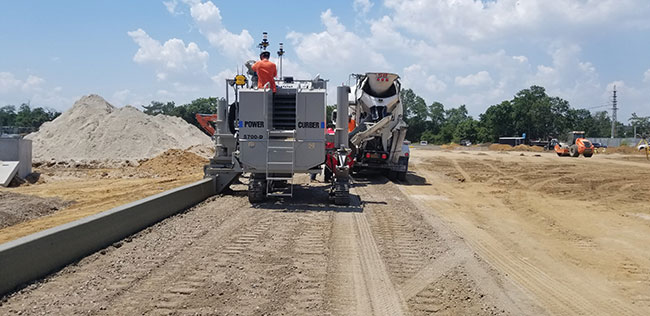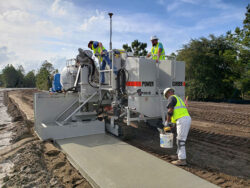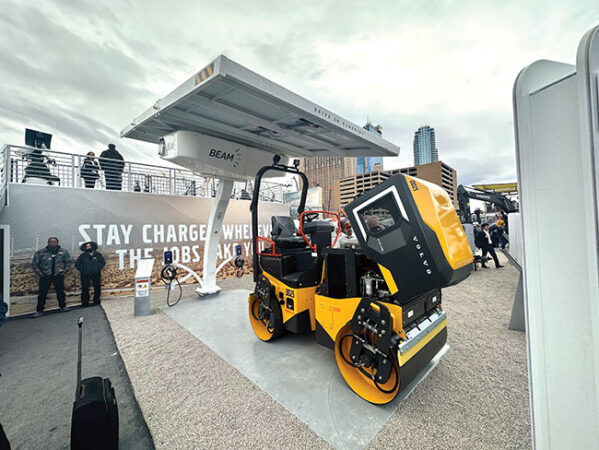
Features
Heavy Equipment
Roads & Paving
Technology
Paving the way forward
Emerging solutions for a changing industry
October 2, 2023 By Jack Burton
 Power Curbers’ stringless machine control solutions allow producers to meet the increased demand for paving projects amidst the reduced labour supply that the industry is facing.
Power Curbers’ stringless machine control solutions allow producers to meet the increased demand for paving projects amidst the reduced labour supply that the industry is facing. Demand for roadbuilding and infrastructure projects is soaring nation-wide, with Canadian road builders having paved their way coast-to-coast nearly eight times between 2019 and 2020.
This is according to Canada’s most recent Core Public Infrastructure Survey, finding more than 43,000 kilometres of road projects to have reached completion between 2019 and 2020. That’s just under eight times the country’s width of 5,500 kilometres at its widest point.
The demand for new and better roads isn’t slowing down. To meet these paving demands, however, a number of issues, like road quality, sustainability, and labour shortages, need to be properly addressed.
Fortunately, manufacturers and equipment providers have been attentive to these issues, with a number of new solutions emerging to help contractors and paving professionals find success by looking to the needs of the industry’s present and future.
Beware of wear and tear
Paving projects across the country range from easing high-traffic corridors to adding infrastructure to remote communities, but one driving need growing in influence, according to Wirtgen Group’s district sales manager for Central Canada Daulta O’Hanlon, is the repair and rehabilitation of worn-down roadways.
“A major challenge over the last few decades has been an increase in the number of vehicles per citizen, as well as a dramatic increase in the average traffic speed and overall load,” said O’Hanlon. “This overloading has strongly shortened the lifespan of pavements.”
These trends highlight the value of solutions that maximize the overall operational lifetime of these roadways and reduce future maintenance needs, especially as contemporary vehicle design shifts toward being more demanding on pavement.
“There have been some major steps taken to improve the quality and performance of pavements, with one of them being the addition of a polymer to bituminous binder,” O’Hanlon explained. “Polymer-modified asphalt has gained some importance as of late, as it now plays a fundamental role in road paving that’s efficient and long-lasting.”
Polymer-modified asphalt is a step toward maximizing the density of pavements to meet current load demands, but O’Hanlon highlighted difficulty exists in replicating the lab results when applying these solutions in the field.
“A perfectly-performing mix in the lab is very challenging to replicate when applied in the field, as it takes more effort to compact in a small temperature zone,” he said. “Also, the polymer-modified mix leaves the asphalt plant at a certain temperature and density, and that gives producers a limited time frame when laying the mix down.”
The screed process increases pavement density by squeezing air out of the mixture that has been laid during the pre-compaction phase. O’Hanlon shared that the common method for this process in North America is to use a vibrating screed to spread the asphalt according to desired road thickness, slope and ride specs.
Wirtgen has approached the screeding process as an opportunity to attempt to replicate the lab testing results of polymer-modified asphalt with the development of the Vögele AB600TV.
The three-metre extending screed uses both a tamper and vibrating approach designed to maximize density during the pre-compaction phase. The AB600TV’s increased density output comes from the tamper design, which pre-compacts the mix before the screed plates reach it.
“With the asphalt pre-compacted, the screed is less susceptible to deviations in the mat, increasing ride spec and putting less pressure on asphalt rollers to achieve density within the desired temperature zone,” O’Hanlon explained.
Adapting sustainably
Asphalt and pavement’s significant contributions to greenhouse gas emissions also means professionals in the roadbuilding industry will have to adjust as legislative regulations surrounding sustainability and carbon output continue to grow in both comprehensiveness and influence on their bottom line.

Reception to Power Curbers’ 3D mapping and smart technology solutions has been overwhelmingly positive from clients making the transition.
“Sustainability goals and regulations are catching on everywhere, so products and solutions that help customers meet those regulations will continue popping up and being fine-tuned in the months and years to come,” said Mark Eckert, product manager for compactors at Volvo CE.
The true demand across the paving industry is not just for solutions that are in alignment with this sustainable future, but for tools that accommodate these changing needs at no expense in quality to the finished product or project, says Eckert.
“Determining the right solutions to dial in productivity and accuracy remain critical parts of our customers’ work and becomes even more of a challenge with how essential protecting profit margins is in the face of all of this,” he said.
Volvo CE considers alternatively powered equipment and smart technology a large part of the company’s future, said Eckert, with a glimpse at this future visible in their DD25 electric asphalt compactor.
Eckert described the machine as a zero-exhaust emission solution for small-scale compaction projects like street repairs and parking lots, that still manages to boast 30 per cent more available power than its counterparts.
“The result is a more responsive machine in terms of speed and vibrations, that performs better on grade thanks to the size of its components, and better at high elevations than diesel machines, which lose power with increased altitude,” said Eckert.
Satisfying increased environmental regulations is not the only avenue where green technology can save paving producers money, with electric solutions also driving down costs in other areas of potential financial burden, such as downtime.
“With no engine to service, and electric components, batteries, and motors all being maintenance-free, upkeep requirements are reduced as well, saving serious time and money,” said Eckert.

Volvo CE is offering a glimpse at paving’s sustainable future in their DD25 electric asphalt compactor.
Working smart
While the high volume of current and forthcoming infrastructure projects are not a problem for paving producers, there is an issue when it comes to contractors having the sufficient labour force to meet these demands.
Regardless of which direction this shortage trends, there may be a light at the end of the tunnel in the form of automation and smart technology, said Stephen Bullock, President at Power Curbers LLC.
“Although there is quite a bit of available work out there, contractors aren’t able to expand their services due to a lack of labor supply,” Bullock said. “Several contractors have commented that they’re hesitant to enter the world of 3D and GPS technology, but that they can no longer find anyone willing to pound pins and set up the stringline [for paving jobs.]”
Bullock highlighted 3D stringless control, a technology trend that Power Curbers has come to specialize in, as a potential solution for meeting demand with quality results, even in the absence of adequate workers.
This solution replaces the traditional method of manually laying the stakes and stringlines used to control elevation with smart technology and robotics, at no compromise to precision.
“Stringless control has really evolved over the past 15 years, with real momentum gained over the last three or four,” Bullock explained. “Machine control is provided through a combination of GPS and robotics to replace the stakes and stringlines traditionally used for controlling elevation and steering slipform machines.”
Despite the recent emergence of this technology, Bullock shared that the reception to it amongst Power Curbers’ customers has been positive, especially with regards to its capabilities and compatibility in overall on-site operations.
“We’ve all been thrilled with how well the integration has gone, and the ease of transition we’ve been able to provide our customers,” he said. “We constantly get positive feedback from machine control partners regarding how smoothly our systems can be integrated relative to other machinery on the market.”
Print this page